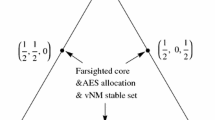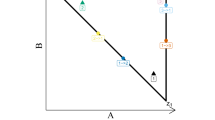Abstract
This paper studies compromise and inflexibility in political negotiations. It provides the first analysis of gridlock, a result in which politicians fail to agree on an ideal compromise but which most voters find preferable to the status quo. A multistage game is developed in which contending political blocs choose from hardline or compromise strategies. The outcomes—compromise, gridlock, or one party's ideal legislation—are a function of the incentives of political actors to cooperate or fight. The model illustrates problems in political markets that may occur when consumers are poorly informed.
Similar content being viewed by others
References
Alesina, Alberto; Cuikerman, Alex. “The Politics of Ambiguity,”Quarterly Journal of Economics, 105, 4, November 1990, pp. 829–50.
Caplin, Andrew; Nalebuff, Barry. “Aggregation and Social: A Mean Voter Theorem,”Econometrica, 59, 1, January 1991, pp. 1–23.
Downs, Anthony.An Economic Theory of Democracy, New York, NY: Harper and Row, 1957.
Goodin, Robert E. “Institutionalizing the Public Interest: The Defense of Deadlock and Beyond,”American Political Science Review, 90, 2, June 1996, pp. 331–43.
Hansson, Ingemar; Stuart, Charles. “Voting Competitions with Interested Politicians: Platforms Do Not Converge to the Preferences of the Median Voter,”Public Choice, 44, 3, 1984, pp. 431–41.
Hirshleifer, Jack. “The Technology of Conflict as an Economic Activity,”American Economic Review Papers and Proceedings, 81, 2, May 1991, pp. 130–4.
Hotelling, Harold. “Stability in Competition,”Economic Journal, 39, March 1929, pp. 41–57.
Ingberman, Daniel; Villani, John. “An Institutional Theory of Divided Government and Party Polarization,”American Journal of Political Science, 37, 2, May 1993, pp. 429–71.
Mathis, Edward J.; Zech, Charles E. “An Examination into the Relevance of the Median Voter Model: Empirical Evidence Offers Support for the Model and Certain Uses,”American Journal of Economics and Sociology, 45, 4, October 1986, pp. 403–12.
Milgrom, Paul; Roberts, John. “Relying on the Information of Interested Parties,”RAND Journal of Economics, 17, 1, Spring 1986, pp. 18–32.
Morton, Rebecca B. “Incomplete Information and Ideological Explanations of Platform Divergence,”American Political Science Review, 87, 2, June 1993, pp. 382–92.
Paine, Scott C. “Persuasion, Manipulation and Dimension,”Journal of Politics, 51, 1, February 1989, pp. 36–49.
Palfrey, Thomas R. “Spatial Equilibrium With Entry,”Review of Economic Studies, 51, 1, January 1984, pp. 139–56.
Poole, Keith; Rosenthal, Howard. “The Polarization of American Markets,”Journal of Politics, 46, 4, 1984, pp. 1061–79.
Romer, Thomas; Rosenthal, Howard. “Bureaucrats versus Voters: On the Political Economy of Resource Allocation by Direct Democracy,”Quarterly Journal of Economics, 93, 4, November 1979, pp. 563–87.
Rothstein, Paul. “Representative Voter Theorems,”Public Choice, 72, 3–4, December 1991, pp. 193–212.
Skaperdas, Stergios; Grofman, Bernard. “Modeling Negative Campaigning,”American Political Science Review, 89, 1, March 1995, pp. 49–61.
Wittman, Donald A. “Candidates with Policy Preferences: A Dynamic Model,”Journal of Economic Theory, 14, 1, February 1977, pp. 180–9.
Author information
Authors and Affiliations
Rights and permissions
About this article
Cite this article
Osborne, E. A theory of gridlock: Strategic behavior in legislative deliberations. Atlantic Economic Journal 26, 238–251 (1998). https://doi.org/10.1007/BF02299342
Issue Date:
DOI: https://doi.org/10.1007/BF02299342




